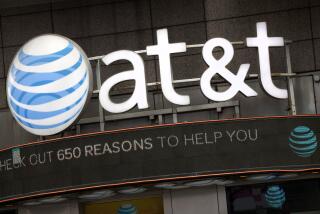C.L. Brown, 82; Ran AT&T; During Breakup
- Share via
Charles L. Brown, who headed AT&T; Corp. when the huge telephone company agreed to the historic breakup of “Ma Bell” nearly 20 years ago, died after a lengthy illness Wednesday in his hometown of Richmond, Va. He was 82.
The 1984 breakup of AT&T;, then known as American Telephone & Telegraph Co., was one of the largest, most tumultuous restructurings in U.S. corporate history. Its ripples have touched everyone since who has dialed a telephone.
At the time, AT&T; had 1 million employees and a monopoly over most phone service. Its breakup unleashed a wave of competition in markets for telephone service and telecommunications equipment, the merits of which are still debated.
Brown, a soft-spoken, polite Virginian, opposed the breakup. He spent his entire 40-year career at AT&T;, becoming its chairman and chief executive in 1979.
But AT&T; was battling a long, costly antitrust suit brought by the U.S. government, which contended that AT&T; was too large and thus detrimental to consumers. Congress was weighing legislation to splinter the company. Technology gains were enabling rivals to eat into AT&T;’s long-distance business.
So Brown decided that the best outcome for AT&T; and its stockholders was to settle the case and help craft the company’s dismemberment.
He and AT&T;’s other directors agreed in 1982 to accept a pact with the government that called for the Bell System to be broken into eight companies. They were the seven “Baby Bells” that provided regional phone service across the country, and a much smaller AT&T;, which kept the long-distance and phone-equipment manufacturing lines.
“Under the circumstances of the time, this was the lesser of evils,” said Howard Trienens, AT&T;’s general counsel from 1980 to 1986.
But Brown “had spent his life in the Bell System, and breaking it up was emotionally difficult for him,” Trienens said Wednesday.
After he retired in 1986, Brown still maintained that the breakup had been a mistake. The company could have evolved into a more consumer-friendly provider with the help of changes in telecommunications rules by the federal government, he said.
But Brown also said that AT&T; had spent seven years and $350 million fighting the antitrust suit, and that years of appeals were still ahead. And ultimately, he said, AT&T; might still lose.
In 1986, he told The Times that his decision had helped the company by “clearing away the restrictions that were binding us” from providing lower prices, faster innovation and better customer service.
Brown’s actions also were praised by some of his adversaries Wednesday.
His acceptance of AT&T;’s breakup “was an act of statesmanship ... not often seen in the corporate world,” said Philip Verveer, who headed the Justice Department’s investigation of AT&T; in the mid-1970s and is now a partner at the law firm Wilkie, Farr and Gallagher.
“He recognized that, one way or the other, the company was going to be significantly restructured,” Verveer said. By settling, Brown won AT&T; “some participation in what, after all, was going to be a very complicated effort.”
“The decision he made was controversial within the company,” Verveer said. “But for the country, for broader society, it turned out to be a correct one.”
Whether that is actually so is still a matter of controversy. The breakup of AT&T; did pave the way for today’s telecommunications world, with cheaper long-distance prices, significant advances in wireless phones and the high-speed Internet services now available.
But many agree that customer service has deteriorated. Whereas AT&T; once took care of almost any phone problem, today’s consumers must deal with a myriad of providers for local and long-distance calling plans, repairs and other service issues, a situation that often breeds confusion.
Through mergers and acquisitions, there are now four companies that operate the original Baby Bells -- BellSouth Corp., SBC Communications Inc., Verizon Communications Inc. and Qwest Communications International Inc. AT&T;’s manufacturing operations were spun off in 1996 into Lucent Technologies Inc.
Charles Lee Brown was born in Richmond on Aug. 23, 1921. His father was a traffic manager for AT&T;, his mother at one time a telephone operator. After receiving a bachelor’s degree in electrical engineering from the University of Virginia in 1943, he entered the Navy and served during World War II aboard the battleship Mississippi.
Brown joined AT&T; in 1946 and began moving up through the company. He was elected chief executive of Illinois Bell in 1969, executive vice president of AT&T; in 1974 and AT&T;’s CEO in 1979.
He lived in Princeton, N.J., but moved to Richmond for nursing care as his health deteriorated. The exact cause of death was not disclosed.
He is survived by his wife Ann; a son, Dr. Charles A. Brown of Kona, Hawaii; and a grandson, Alexander Lee Brown of Bakersfield.
A memorial service is scheduled for Saturday at St. Mary’s Episcopal Church in Richmond.
More to Read
Inside the business of entertainment
The Wide Shot brings you news, analysis and insights on everything from streaming wars to production — and what it all means for the future.
You may occasionally receive promotional content from the Los Angeles Times.










